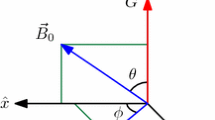31
P nucleus can be used to represent a quantum bit (‘qubit’) with a relatively long relaxation time. In a CeP crystal lattice, 31P nuclei are periodically situated in three dimensions at distances of about 6 Å. The application of a static magnetic field gradient in one direction causes differences in the Zeemanfrequencies of separate nuclei. This allows thousands of distinct qubits to be individually addressed. Initializations of the qubits can be done efficiently by the Pound–Overhauser double resonance effect on the nuclear spins and the antiferromagnetically ordered 4f electron spins of cerium ions. Logic operations can be performed by simple pulse sequences, and computational results after logic operations can be measured by the nuclear magnetic resonance of neighboring nuclei, or the electron resonance of neighboring 4f electrons of cerium ions.
Similar content being viewed by others
Author information
Authors and Affiliations
Additional information
Received: 26 October 1998/Accepted: 29 October 1998
Rights and permissions
About this article
Cite this article
Yamaguchi, F., Yamamoto, Y. Crystal lattice quantum computer . Appl Phys A 68, 1–8 (1999). https://doi.org/10.1007/s003390050846
Issue Date:
DOI: https://doi.org/10.1007/s003390050846



